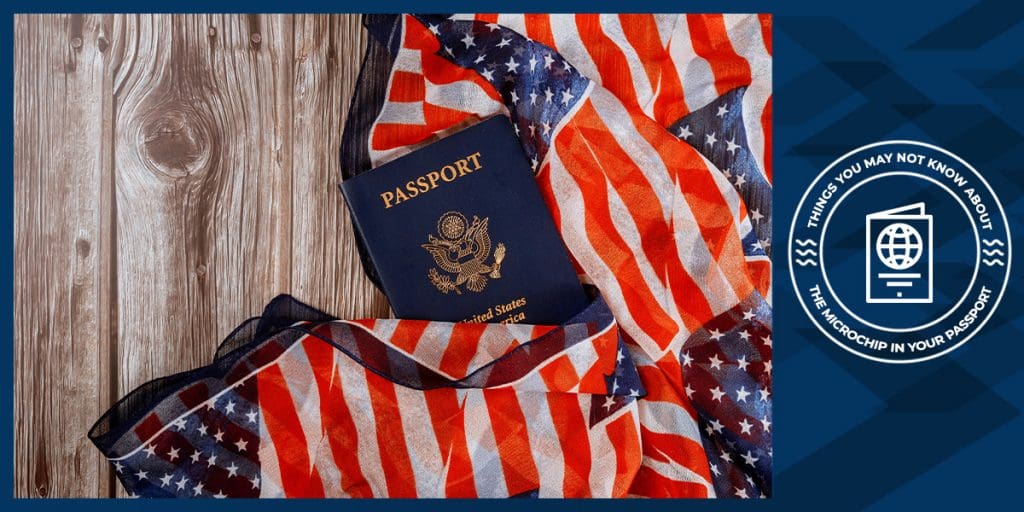Did you know that there is a tiny microchip inside your passport? Yes, really! But there’s no need to worry. The microchip is only there to help! It has many features, including working to help protect you against identity theft if your passport gets stolen.
What Are RFID Chips?
Radio Frequency Identification chips are microchips that are used to store information securely. They have been around for many years in different products worldwide but have been used in passports dating back to 2007. Their main purpose is to securely store information and help protect you from threats such as identity theft.
Why is There a Chip in My Passport?
Believe it or not, there are actually numerous high-tech security features in your passport, including an RFID microchip. RFID microchips have been embedded inside all passports issued since 2007 and securely store personal contact information. These chips are inside your passport in case it gets lost or stolen. In the chance that your passport does go missing and someone tries to change the picture or name on your passport, a customs agent will still be able to scan the passport and can see that the information doesn’t match up.
What Exactly is the Microchip Used For?
The microchip in your passport stores the personal contact information found on the photo page of your passport. It is there to help prevent you from becoming a victim of identity theft. If someone steals your passport and tries to change the picture or name on it, a customs agent will be able to scan your passport and see that the information doesn’t match up.
Is the Microchip Found in My Passport Secure?
The microchip in your passport is very secure. For someone to steal your information and scan your passport, your passport would have to be wide open. As long as you keep your passport closed and in a secure area, no one should be able to scan the chip in your passport.
If someone does gain access to your passport and scans your microchip, they will not be able to access other sensitive information about you such as your FBI file or tax returns. This type of information is not stored on your passport’s microchip.
Where Else Are RFID Chips and Microchips Used?
RFID chips are commonly used around the world. Some of the items you will frequently see RFID chips in are hotel keys, student ID cards, company ID cards, and passports in more than 80 countries across the globe. There are also similar microchips that can be found in credit cards. These microchips tend to contain significantly more information than the information found on your U.S. passport RFID chip.
How Can I Check if My Passport Chip is Damaged?
The only way to tell if your passport is damaged is when you go to the airport for a trip and have it scanned by a customs agent. They’ll be able to tell you if your chip is damaged and malfunctioning. Though this may not be the most convenient option for you, considering that you won’t be able to go on your trip if your chip is damaged.
Who Can I Contact With Any Further Questions?
Since 2008, Swift Passport and Visa Services has been the go-to choice for busy travelers needing expedited passports and visas. Swift has some of the highest customer ratings and reviews in the industry, and with a network of partnerships nationwide, Swift Passport Services can reach clients in all 50 states. Swift is authorized by the US Department of State and has access to all foreign consulates nationwide in six major cities.
If you’re looking to obtain an expedited passport or visa or have any further questions or concerns about the RFID chip in your passport, please don’t hesitate to contact us. Our team of experts would be happy to answer any questions you may have. No matter where you’re going in the world, we’ll get you there!

4 thoughts on “Things You May Not Know About the Microchip in Your Passport”
very little they could do with? ever heard of identity theft? i doubt the passport covers can prevent reading by a powerful rfid scanner. in fact they should’ve put aluminum foil in the passport covers to make it rfid protected and not just assume the plastic would protect it cos it probably doesn’t. so yeah they made people a whole lot less secure with this stunt.
I just moved and it seems my passport is missed placed. Can I buy a rfid detector to try and find it?
Yes should work. You can boost the range on an NFC phone by simply using a piece of Sellotape coated with pyrolytic graphite: a good source is old phone screens and Iphone thermal pads. Should look like a matt black covering when done.
Pingback: What Is RFID Theft? What To Know Plus An Affordable & Easy Hack